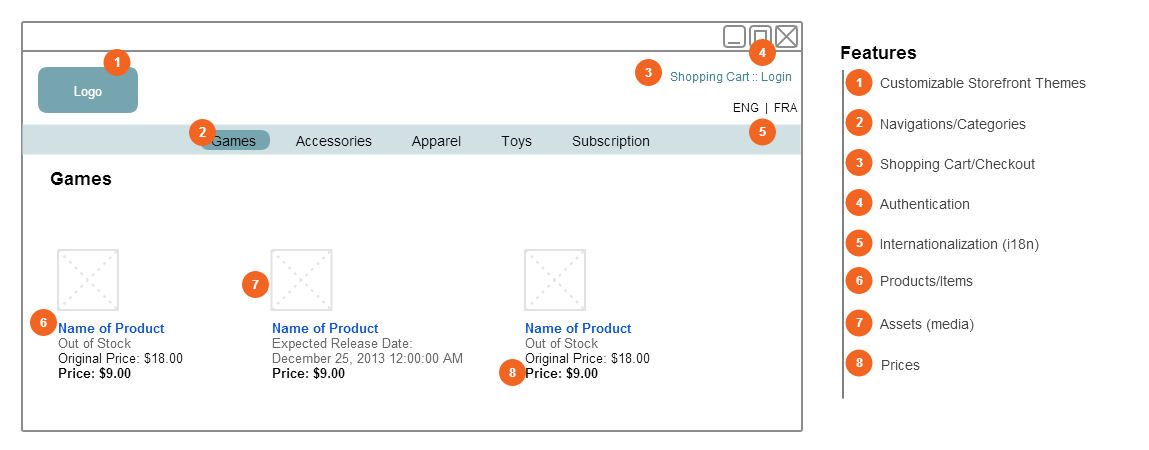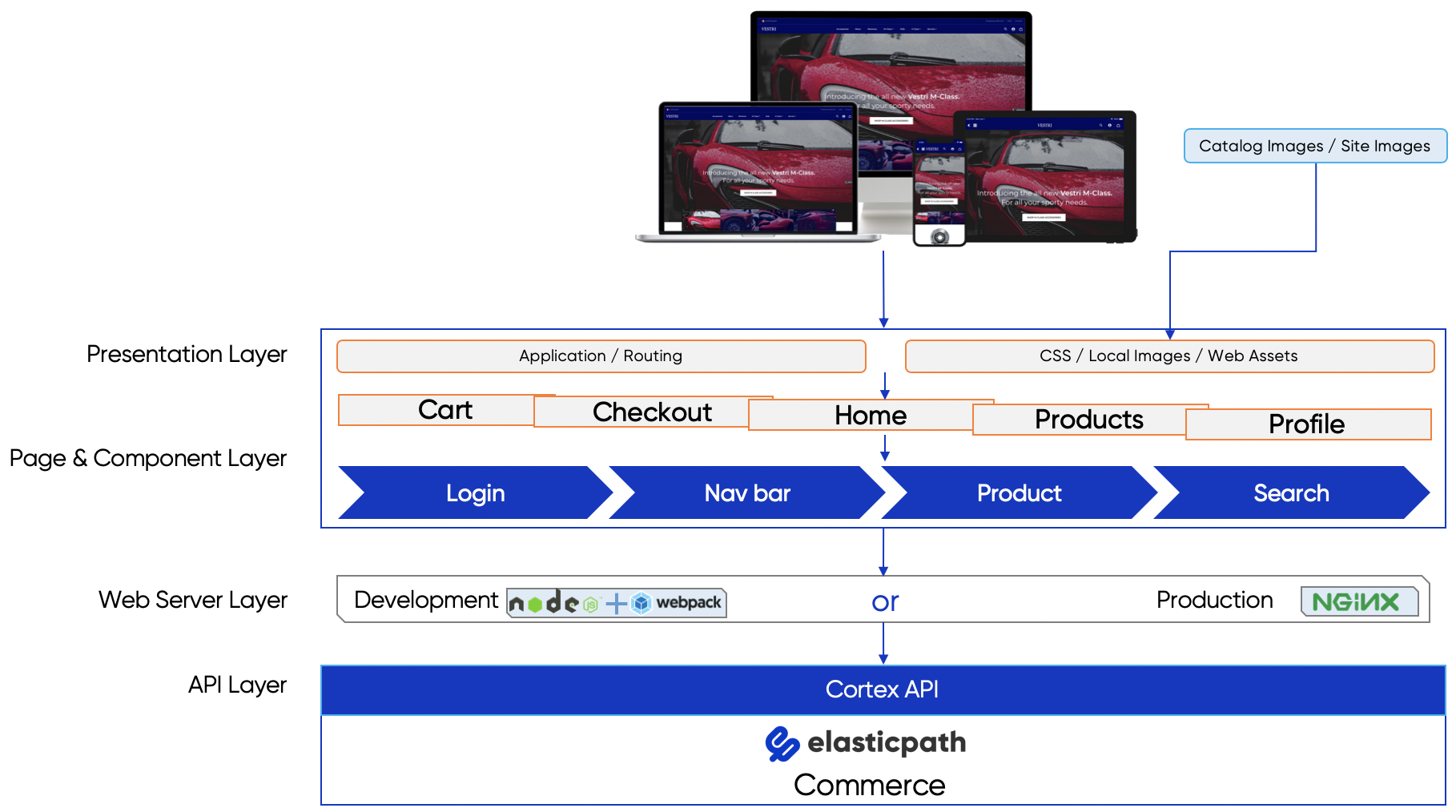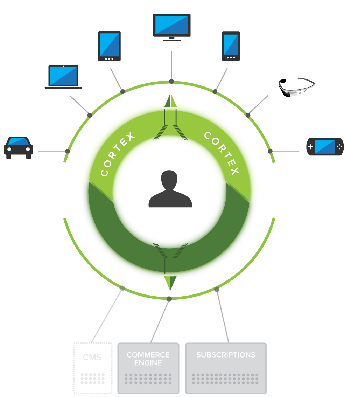Overview of the React PWA Reference Storefront
The React PWA Reference Storefront (the storefront) is a flexible e-commerce website built on the Elastic Path RESTful e-commerce API, called Cortex API. Through Cortex API, the storefront uses the e-commerce capabilities provided by Elastic Path Commerce and retrieves data in a RESTful manner.
The storefront is composed of containers (pages) and React components. Each page in the storefront is composed of various components that fulfills the purpose of the page.
For example, the storefront has the following pages:
- Home
- Cart
- Categories
- Checkout
- Registration
Each page contains a set of components, such as:
- Navigation
- Footer
- Product list
- Products
The storefront is designed as an open source mobile Progressive Web Application (PWA) that has the capabilities for local browser storage page caching and persistent session management.
This PWA is built using the following technologies:
The storefront uses Storybook as a tool to build UI components in isolation. It organizes them for consumption in other implementations that may use the components.
With theming, you can change the presentation of the storefront. The storefront uses the dynamic stylesheet language, scss, to change the styling of the store. You can change the look and feel of the storefront by modifying the corresponding {scss} files.
Each component and page contains {scss} files, which can be compiled into a style.css file. The {scss} files for each component/page are organized in the same order as the storefront is presented.
For example, CartPage.scss contains CSS for the cart’s container page, and cart.main.scss contains CSS for the main component in the cart page.
Features
In the storefront, e-commerce functionality such as cart, authentication, profile, search are part of the respective components. Each component makes the independent Cortex calls to retrieve the data it needs from the backend. The front-end developers need not change JavaScript to update the CSS files to style/brand their store. Each customization layer is separated into its own layer from the core code, so developers need not change the storefront utility engine unless desired.
You can access the storefront on various devices, such as tablets, smart phones, or computers.

Platform Architecture
The React PWA Reference Storefront is composed of layers that work together to provide various capabilities to operate the storefront. The following diagram shows the storefront architecture:

- Presentation Layer: Provides the user interface management capabilities using a modern UI framework and routes browser requests to the subsequent pages. The files in this layer are:
index.html- The front-end html document that is populated by the React pages and componentsApp.tsx- The javascript file that contains the import instructions for the React components and the subsequent layers. When this script is run, all subsequent components are loaded on the pageindex.tsx- The javascript file that contains the import instructions for the required frameworks, such as bootstrap, React, and renders theApp.tsxfile. This file also registers the PWA service worker- CSS - The file that consists of the custom stylesheets and static page assets for the storefront front-end presentation
routes.ts- The javascript file that contains routes and mappings to the React pages- Service worker - A service worker created using Workbox to manage caching and PWA capabilities
- Catalog & Site Images: Externally hosted catalog and site content images. Can be hosted on a CMS (Content Management System) or CDN (Content Delivery Network) of choosing
- Page & Component Layer: The top-level pages that loads the required components for each page. Provides the components to be loaded within each page. The components are created depending on the functionality of the item that the pages interact with or loads. For example, the component layer provides the login component for the home page
- Web Server Layer: Enables the interaction between the application and the service layer
- API Layer: The application layer of the React PWA Reference Storefront is built on Cortex API. Through the Cortex API, the storefront gets to use the e-commerce capabilities provided by Elastic Path Commerce. PWA interacts with the required services through this layer
Cortex Integration
The storefront invokes Cortex APIs to ensure that the best practices of consuming hypermedia APIs are followed.

By modifying the following files, you can customize the API calls that make the REST HTTP request:
- The
Cortex.tsfile contains the methods and classes that fetch data for the API calls made to Cortex. You can customize this file with additional headers or generic request modifications in thecortexFetch()function for custom implementations. This file also includesx-headersand the ability to add any additional headers - The
AuthService.tscontains the authentication functions used to authenticate users with Cortex using OAuth2. The OAuth tokens are saved in the local storage of the web application. For authenticating subsequent Cortex requests, the tokens are retrieved and added into the header - The
CortexLookup.tscontains the functions used to perform lookups on the forms provided by Cortex, and saves them in the local storage of the web application
You can create zoom queries by populating an array with all required queries and appending it to the request to Cortex. When you create a zoom query, request only the additional data needed by the component using the query. Elastic Path recommends to avoid requesting unnecessary data, and circular zooms for better performance.
Workflow
- The top-level root for the REST call is retrieved from Cortex. This URL consists of related links that provides URLs to the children of the root
- After retrieving the root level, subsequent actions are performed against Cortex on the children of the root, depending on the action intended to be performed by the React Component initiating the REST request
Note: For the subsequent calls, the storefront must call only the URL that Cortex returns when you call the root. You must not create custom URL in the storefront component settings to ensure that any change in the API names do not change the URL. Use the
relsin Cortex response to make subsequent calls. However, for the OAuth implementation, you might want to create a URL in the storefront.